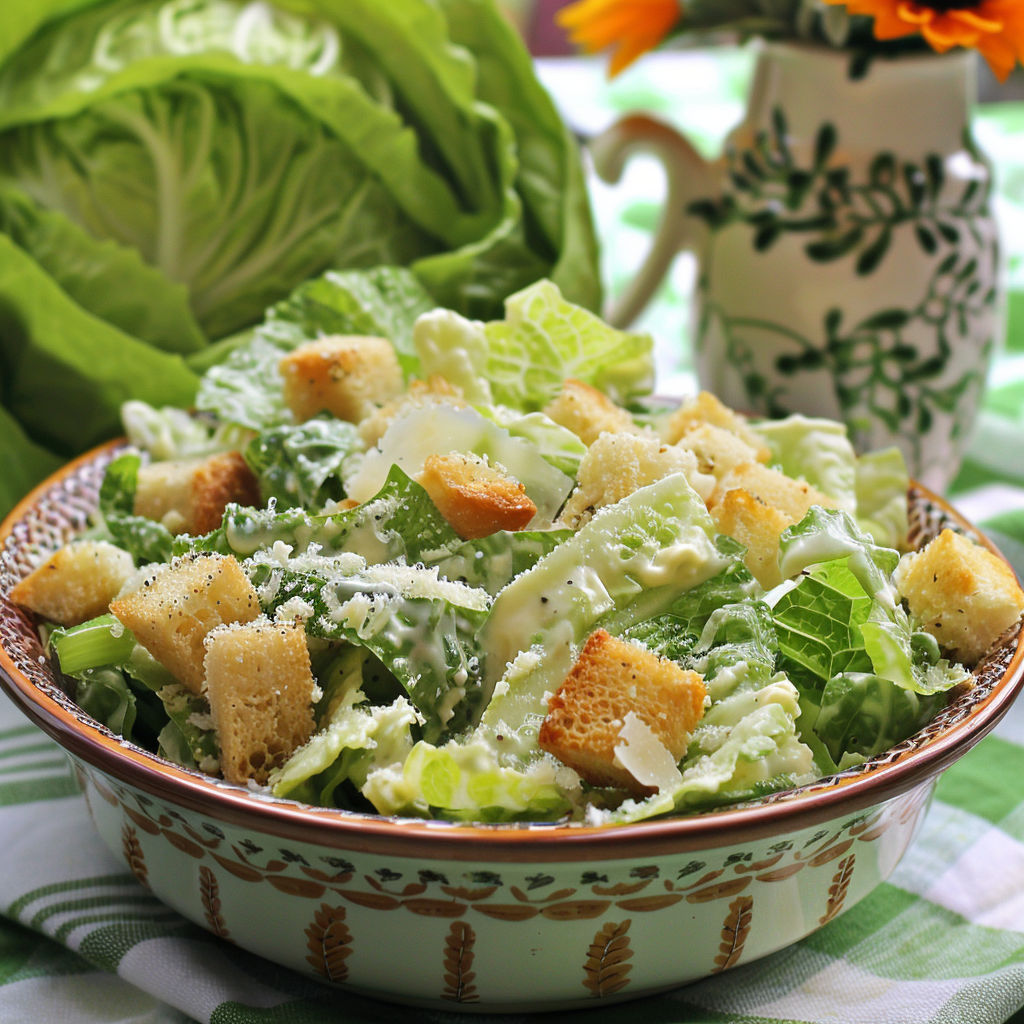Classic Caesar Salad Recipe with Homemade Dressing and Croutons

Share
Caesar Salad: My Go-To for a Satisfying Meal
Whenever I’m at a restaurant and faced with too many heavy options or things that don’t appeal to me, I always turn to a classic Caesar salad. It’s refreshing, reliable, and fills me up without being too much. There’s just something about that perfect mix of crisp romaine lettuce, creamy dressing, and crunchy croutons that always hits the spot. Over time, though, I’ve learned that not all Caesar salads are the same. The dressing can be too creamy, or too heavy, or occasionally, I’ll end up with surprise bacon—definitely not my favorite! But, when it’s done right, it’s a satisfying, lighter meal I can always count on, even when I’m not sure what else to order.
Did You Know?
Caesar Salad was created by Italian-American restaurateur Caesar Cardini in Tijuana, Mexico, in the 1920s. Fun fact: The original recipe included whole romaine leaves, which were meant to be eaten with fingers, not forks!
Yield: Serves 6
Ingredients:
- 1 large head of romaine lettuce, washed and chopped
- 1/2 cup grated Parmesan cheese
- 1 cup croutons
Dressing:
- 1/2 cup mayonnaise
- 1/4 cup grated Parmesan cheese
- 1 tablespoon lemon juice
- 1 teaspoon Worcestershire sauce
- 1 clove garlic, minced
- 1/2 teaspoon Dijon mustard
- Salt and pepper to taste
Instructions:
Prepare Lettuce: In a large bowl, combine the chopped romaine lettuce.
Make Dressing: In a small bowl, whisk together the mayonnaise, grated Parmesan cheese, lemon juice, Worcestershire sauce, minced garlic, Dijon mustard, salt, and pepper.
Personal Tip: Taste the dressing before tossing to adjust seasoning if necessary.
Toss Salad: Pour the dressing over the lettuce and toss to coat evenly.
Personal Tip: Use chilled lettuce for a crispier texture.
Add Toppings: Sprinkle with the grated Parmesan cheese and croutons.
Serve: Serve immediately.
Personal Tip: Add freshly cracked black pepper for extra flavor.
Nutritional Information (Per Serving): Calories, 200, Protein, 5g, Carbohydrates, 10g, Fiber, 2g, Net Carbohydrates, 8g, Fat, 16g, Saturated Fat, 4g, Cholesterol, 20mg, Sodium, 400mg, Sugars, 2g, Glycemic Index, Medium
Kitchen Tips, Great Ideas, How to Save Money
-
Lettuce Options: Use fresh, crisp romaine hearts for the best texture and flavor. You can also mix in other greens like kale or arugula for variety.
-
Homemade Croutons: Make your own croutons by toasting cubed bread with olive oil, garlic powder, and Italian seasoning in the oven at 350°F (175°C) until golden brown.
-
Cheese Alternatives: For a different flavor, try using Pecorino Romano or Asiago cheese instead of Parmesan.
-
Adding Protein: Turn this salad into a main course by adding grilled chicken, shrimp, or salmon.
-
Storing Leftovers: Store leftover salad and dressing separately in airtight containers in the refrigerator for up to 2 days. Toss together just before serving.
-
Dressing Variations: For a lighter version, use Greek yogurt instead of mayonnaise. For a more authentic Caesar dressing, add 2-3 anchovy fillets (mashed) to the dressing.
-
Serving Suggestions: Serve this salad as a side dish with pasta, grilled meats, or seafood.
-
Reducing Sodium: Use low-sodium Worcestershire sauce and reduce the amount of salt in the dressing.
-
Flavor Enhancements: Add a splash of white wine vinegar or a teaspoon of capers to the dressing for extra tanginess.
-
Cost-Saving Tips: Buy romaine lettuce and Parmesan cheese in bulk when they are on sale. Using store-brand mayonnaise and Worcestershire sauce can also help reduce costs without sacrificing quality.
Let’s Learn About Romaine Lettuce
Romaine lettuce, known for its crisp texture and mild flavor, is a staple in many salads, including Caesar salads. It's grown in rows, often in well-drained soil, and thrives in cooler climates. Farmers tend to use conventional and organic methods to cultivate romaine. When conventionally grown, romaine may be exposed to pesticides, making it essential to wash thoroughly before consumption.
What to Watch For: When shopping for romaine, look for bright green leaves that are free from wilting or brown spots. Organic romaine is an excellent choice if you're concerned about pesticide use, but even with organic produce, it's important to clean it properly.
How to Clean Romaine: One of the most effective ways to clean romaine lettuce is to soak it in a vinegar solution (a 3:1 ratio of water to vinegar) for about 10 minutes. This helps remove dirt, bacteria, and pesticide residue. After soaking, rinse the leaves thoroughly under cold water and dry them with a salad spinner or paper towels.
Romaine's mild flavor and crunchy texture make it perfect for salads, sandwiches, and wraps, but proper cleaning is essential to ensure you're eating the healthiest version possible.


